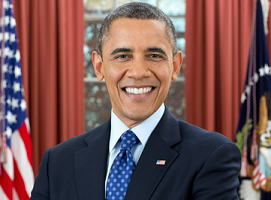White House Unveils ConnectALL Broadband Initiative

The White House is doubling down on boosting broadband connections, including going all-in on the FCC's proposed Lifeline reforms, being voted at the FCC's March 31 public meeting, and setting a goal of connecting 20 million more Americans by 2020.
That came in the President's announcement Wednesday (March 9) of a ConnectALL initiative. The name certainly dovetails with the FCC's interpretation of reasonable advanced telecom deployment, which is universal access. The Administration also noted that Cox had pledged to boost its low--cast broadband efforts.
The announcement came only a day after Chairman Tom Wheeler circulated his proposed reforms, which dovetailed with the White House proposal.
President Obama early on made broadband deployment a priority, and Wheeler has certainly followed that lead.
"During President Obama’s seven years in office, we’ve seen unprecedented gains in wiring our nation for the future, including a tripling of the average home Internet speed, covering 98% of Americans with fast 4G/LTE mobile broadband, and doubling the number of schools connected to high-speed Internet," the White House said. "As a result, we’ve seen a technology sector that spans coast to coast, the creation of millions of high-paying jobs, and a revolution in the way students learn in the classroom."
But the Administration clearly thought more was needed to "further" those efforts.
That included a filing by the National Telecommunications & Information Administration (NTIA) in support of the FCC's Lifeline reform proposal, the centerpiece of which is migrating the $9.95 per month subsidy from phone to stand-alone broadband--currently the subsidy can go to bundled broadband and phone, which will continue, but has not been useable for standalone broadband.
Broadcasting & Cable Newsletter
The smarter way to stay on top of broadcasting and cable industry. Sign up below
The Lifeline program is a subsidy for advanced telecommunications to low income households. It is paid into by telecom customers, though not Internet Service Providers.
The White House was billing it as a recommendation that the FCC reform the $1.5 billion program into a broadband subsidy, so in essence it was preaching to the choir since Wheeler had already circulated the proposal just the day before. The FCC is also proposing bumping the subsidy from $1.5 billion to $2.25 billion.
NTIA also said specifically it thought the program should:
"Expand the Lifeline program to support broadband services while ensuring that voice service remains available for low income individuals and communities;
"Subsidize Lifeline services for as long as subscribers’ incomes qualify them for program benefits and they desire the supported services;
"Leverage other federal and state low-income assistance programs, including coordinating enrollment and outreach, to increase the efficiency and effectiveness of Lifeline and these other complementary low-income assistance programs;
"and Establish a national third-party verifier to determine low-income consumers’ eligibility to receive easy-to-use portable Lifeline benefits, either through a direct benefit or other means."
The Administration also released a study on the economic importance of broadband.
But wait, there's more. The initiative also includes:
1. The General Services Administration will head up an inter-agency effort to "re-engineer the Computers for Learning program to expand access to devices for more organizations that help provide digital literacy and training for low-income Americans."
2. The NTIA will launch the Community Connectivity Initiative, which "will create a comprehensive online assessment tool to help community leaders identify critical broadband needs and connect them with expertise, tools, and resources for overcoming the challenges to expanded broadband deployment and adoption."
Helping design the tool will be groups representing computer companies government officials including The American Library Association; Blandin Foundation; ConnectME Authority; EveryoneOn; ICMA, The International City/County Management Association; National Association of Counties; National Association of Telecommunications Officers and Advisors; National Digital Inclusion Alliance; National League of Cities; New America’s Open Technology Institute; Next Century Cities, NetworkMe, NTCA-The Rural Broadband Association; Schools, Health, and Libraries Broadband Coalition.
It was not immediately clear whether that program would be supporting municipal broadband buildouts, but the White House fact sheet did say the initiative would support broadband planning and infrastructure deployment, and the above groups included fans of municipal broadband.
The study also pointed to the President's support of preemption, saying: "Until recently, so me of the communities that have relied on municipal broadband to increase competition namely those in North Carolina and Tennessee, were subject to state laws designed to protect private broadband providers from government competition. The FCC ruled in February 2015 that it would preempt such regulations, a move supported by the Administration."
3. The Administration also gave Cox props for announcing today it will host more than 200 events across the country for low income k-12 families and automatically qualifying for their low-cost broadband program. Cox will also promote it via programming, PSA's and events in tandem with Univision in markets including Phoenix, Las Vegas and San Diego.
Contributing editor John Eggerton has been an editor and/or writer on media regulation, legislation and policy for over four decades, including covering the FCC, FTC, Congress, the major media trade associations, and the federal courts. In addition to Multichannel News and Broadcasting + Cable, his work has appeared in Radio World, TV Technology, TV Fax, This Week in Consumer Electronics, Variety and the Encyclopedia Britannica.

